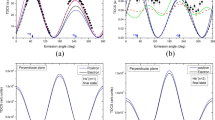Abstract
The emission probability of Intermediate Mass Fragments (IMFs) in non-central reactions has been investigated in collisions of heavy \(^{124}\hbox {Xe}\) projectiles with the two different medium-mass targets of \(^{64}\hbox {Ni}\) and \(^{64}\hbox {Zn}\) at the laboratory energy of 35 A MeV. The two colliding systems differ only for the target atomic number Z and, consequently, for the isospin N/Z ratio. The probability of IMFs emission from the projectile-like fragment has been measured, showing an enhancement of the IMFs emission for the neutron rich \(^{64}\hbox {Ni}\) target. Most of the observed projectile break-up yield is associated with the production of only one IMF, that is, a quasi-binary splitting of projectile in two fragments in a broad range of charge asymmetry. For the events with one IMF, the relative contributions of the dynamical and statistical emissions have been evaluated. We find an enhancement of dynamical break-up probability for the neutron rich target with respect to the neutron poor one. The analysis suggests influence of the target isospin in inducing the dynamical break-up of projectile-like fragments. The new data have been also compared with previous published results of \(^{112,124}\hbox {Sn}\) + \(^{58,64}\hbox {Ni}\) systems, in order to disentangle between isospin effects against system-size effects on the emission probability. The comparisons between previous and new data suggest that the dynamical break-up is determined by the N/Z content of both projectile and target; for the cases here investigated, the influence of the system size on the dynamical emission probability can be excluded.










Similar content being viewed by others
Data Availability Statement
This manuscript has no associated data or the data will not be deposited. [Authors’ comment: Data generated during this study are contained in this published article].
Notes
For the sake of simplicity, we assume that in a semi-peripheral collision of a projectile P and a target T, the binary (at first) system PLF* + TLF* is formed, \(P+T\rightarrow PLF^{*}+TLF^{*}\). A two-step-decay scenario is assumed: The IMF is emitted from the projectile primary fragment PLF* (or TLF*), \(PLF^{*}\rightarrow PLF+IMF\). In the analysis, the PLF* is reconstructed from the PLF-IMF pair, neglecting neutrons and light charged particle (\(Z\le 2\)) emission.
References
P. Glässel, Dv Harrach, H. Specht, Z. Phys. A 310, 189 (1983)
G. Casini et al., Phys. Rev. Lett. 71, 2567 (1993)
A.A. Stefanini et al., Z. Phys. A 351, 167 (1995)
J. Töke et al., Phys. Rev. Lett. 75, 2920 (1995)
J. Dempsey et al., Phys. Rev. C 54, 1710 (1996)
J. Łukasik et al., Phys. Rev. C 55, 1906 (1997)
R. Laforest et al., Phys. Rev. C 59, 2567 (1999)
D. Theriault et al., Phys. Rev. C 71, 014610 (2005)
E. De Filippo et al., Phys. Rev. C 71, 044602 (2005)
E. De Filippo et al., Phys. Rev. C 71, 064604 (2005)
M. Di Toro, A. Olmi, R. Roy, Eur. Phys. J. A 30, 65 (2006)
M. Papa et al., Phys. Rev. C 75, 054616 (2007)
S. Piantelli et al., Phys. Rev. C 76, 061601 (2007)
P. Russotto et al., Phys. Rev. C 81, 064605 (2010)
A. McIntosh et al., Phys. Rev. C 81, 034603 (2010)
E. De Filippo et al., Phys. Rev. C 86, 014610 (2012)
A. Rodriguez Manso, A. McIntosh, A. Jedele, K. Hagel, L. Heilborn, Z. Kohley, L. May, A. Zarrella, S. Yennello, Phys. Rev. C 95, 044604 (2017)
A. Jedele et al., Phys. Rev. Lett. 118, 062501 (2017)
A. Pagano et al., Nucl. Phys. A 734, 504 (2004)
E. De Filippo, A. Pagano, Eur. Phys. J. A 50, 32 (2014)
F. Bocage et al., Nucl. Phys. A 676, 391 (2000)
P. Russotto et al., Phys. Rev. C 91, 014610 (2015)
B.A. Li, W.U. Schröder (eds.), Isospin Physics in Heavy-Ion Collisions at Intermediate Energies (Nova Science, New York, 2011)
V. Baran, M. Colonna, V. Greco, M. Di Toro, Phys. Rep. 410, 335 (2004)
B.A. Li, L.W. Chen, C.M. Ko, Phys. Rep. 464, 113 (2008)
M. Oertel, M. Hempel, T. Klähn, S. Typel, Rev. Mod. Phys. 89, 015007 (2017)
A. Pagano, Nucl. Phys. News 22, 28 (2012). And refs. therein
S. Aiello et al., Nuclear Instrum. Methods Phys. Res. A 369, 50 (1996)
M. Alderighi et al., IEEE Trans. Nuclear Sci. 52, 1624 (2005)
E.V. Pagano et al., EPJ Web Conf. 117, 10008 (2016). And refs. therein
L. Acosta et al., J. Phys. Conf. Ser. 730, 012001 (2016)
E.V. Pagano, et al., in preparation
C. Cavata et al., Phys. Rev. C 42, 1760 (1990)
D. Lacroix, A. Van Lauwe, D. Durand, Phys. Rev. C 69, 054604 (2004)
V. Baran, M. Colonna, M. Di Toro, Nucl. Phys. A 730, 329 (2004)
M. Colonna, M. Di Toro, G. Fabbri, S. Maccarone, Phys. Rev. C 57, 1410 (1998)
V.E. Viola, K. Kwiatkowski, M. Walker, Phys. Rev. C 31, 1550 (1985)
Acknowledgements
We thank the INFN-LNS staff for providing both beams and targets of excellent quality. We are grateful also to the electronics, advanced technology and mechanical design staffs of INFN-division of Catania.
Author information
Authors and Affiliations
Corresponding author
Additional information
Communicated by A.F. Di Pietro
Rights and permissions
About this article
Cite this article
Russotto, P., De Filippo, E., Pagano, E.V. et al. Dynamical versus statistical production of Intermediate Mass Fragments at Fermi Energies. Eur. Phys. J. A 56, 12 (2020). https://doi.org/10.1140/epja/s10050-019-00011-z
Received:
Accepted:
Published:
DOI: https://doi.org/10.1140/epja/s10050-019-00011-z




